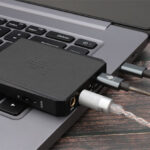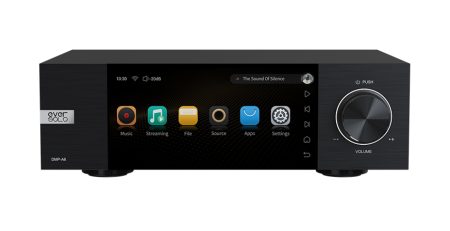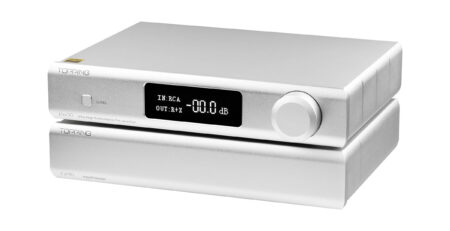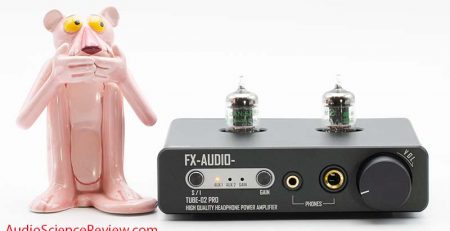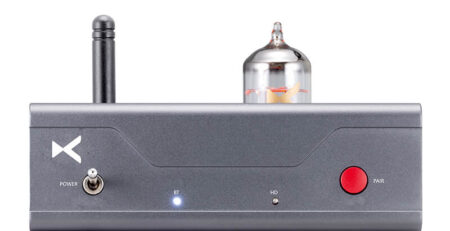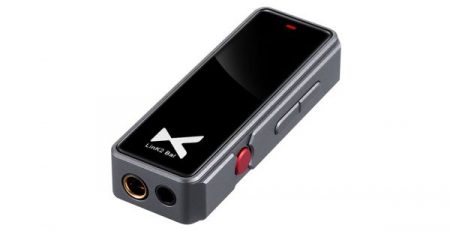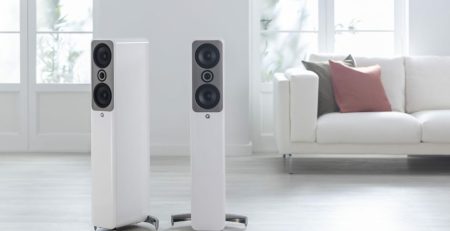Hidizs DH80s Review
The Hidizs DH80s is a compact portable ESS9281C implemented and MQA capable DAC and headphone amplifier.
Eagle-eyed readers will notice that we covered the Hidizs DH80 earlier this year via Mike. This was a unique spin on a concept I had not seen since the CEntrance Glove A1 several years ago. A portable amplifier and DAC with a design purposed entirely around an integrated fitting with their AP80 or AP80 Pro DAPs.
This time around we have its sibling, the DH80s which carries many of the features of the DH80 but this time without the specific DAP fitting. This universal fit will appeal to anyone who wants a portable amplifier and DAC and not just an existing Hidizs DAP user.
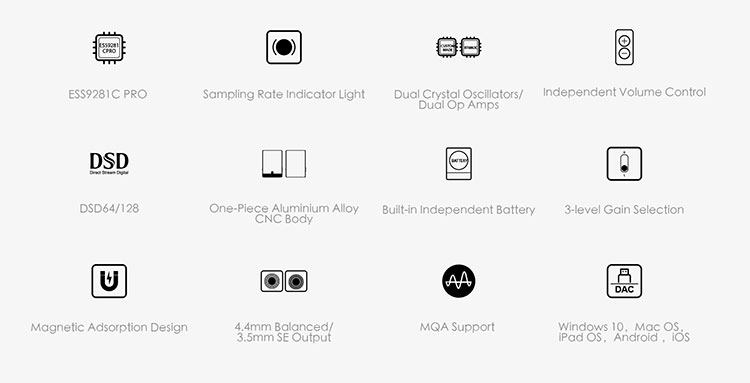
TECH HIGHLIGHTS
Embedded deep within its unibody chassis, Hidizs has implemented an ESS9281C Pro DAC, and dual independent RT6863C op-amps.
According to Hidizs’ official website, the ESS9281C Pro DAC boasts improved power efficiency, a widened dynamic range, and minimal signal-to-noise measurements (116dB for both 3.5mm single-ended and 4.4mm balanced outputs). Hence, the DH80s is compatible with both DSD and MQA-formats, offering sampling rates as high as 32bit/384kHz.
Moreover, its RT6863C op-amp array offers enhanced amplification of up to 125mW+125mW into a 32Ω load in its 3.5mm single-ended output, and 210mW+210mW in its 4.4mm balanced output.
Pair that with a 1300mAh battery, and you have a portable amplifier that (allegedly) offers over 6-8 hours of playback. Tech-wise, the DH80s is no slouch when it comes to boasting technically impressive specs. But real-world performance is the real proof in the pudding.

DESIGN
Aesthetically, the DH80s is a sleek and svelte portable DAC/Amp at 70×50×12mm. For ease of comparison, it is appropriately sized compared to its DAP forbear, the Hidizs AP80 Pro, a highly pocketable solution for outdoor listening.
The front faceplate is finished with a sheet of leather with the Hidizs logo embossed in its center. In addition, the DH80s’ design language borrows a few noteworthy cues from brands such as Astell & Kern, with angular corners that are distinctly achievable on CNC machining processes.
Moreover, its chassis is fabricated from black stainless steel with a satin finish; a pragmatic design decision that circumscribes the possibility of hairline scratches or scuffs as compared to a highly polished surface.
At just 68g, the DH80s was designed to complement or enhance one’s “on the go” audiophile rig without adding too much-unwanted weight. However, its black stainless steel does offer enough heft to inspire confidence in its build quality.
Battery-wise, the DH80s boasts a 1330mAh 3.7 Li-Polymer battery. According to Hidizs should last 6 hours on the balanced output, and 8 hours on the SE output. From daily real-world usage (1hr of listening on the daily commute per day), the DH80S was approximately 35 minutes shy of the company’s estimates. Battery performance is decent, but nothing to write home about.
To put it brusquely, the DH80’s premium design and build quality punches above its price-point significantly.
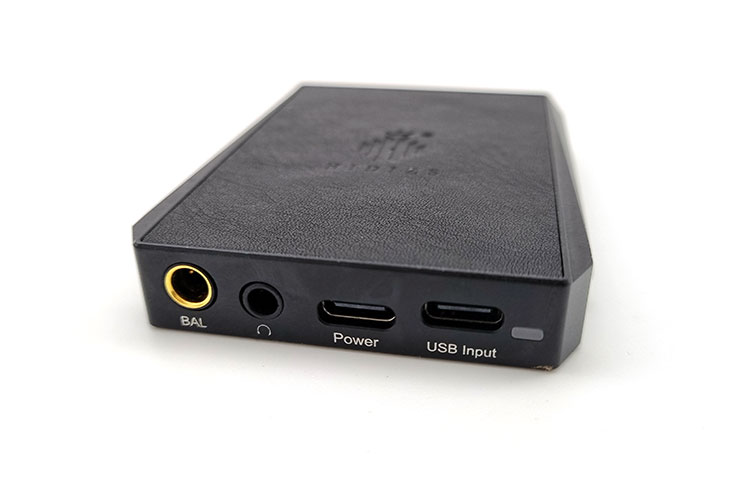
I/O
All the DH80s inputs are conveniently located and named accordingly at the bottom for ease-of-use when inter-operated with a playback soured connected to it.
From the left-hand side, the DH80s hosts a 4.4mm balanced output, and a 3.5mm single-ended output. Hidizs made the right call by opting for the 4.4mm standard instead of the 2.5mm balanced output; manufacturers are slowly distancing themselves from the legacy 2.5mm connector, slowly embracing the 4.4mm as the new normal.
On its right-hand side, there are two independent USB-C inputs: one for charging the device, and the other for receiving audible data from your current source.
While some may detest the inconvenience of having two independent inputs for both charging and data transfer, isolating them from one another lowers the amount of SNR or electro-magnetic interference (EMI) that can potentially pollute or distort the audible signal being received by the DH80s.
Above all, being able to charge your device whilst using it is another additional feature that is attained from splitting both data and power outputs into two distinct sections.
Most importantly, there is a LED indicator at the far right-hand side of the inputs/output section. The LED indicator responds to the amount of audible data being received by the unit as outlined: Red: 44.1k-48k / Blue: 88.2k-384k / Pink: MQA.
The implementation of the LED indicator is highly intuitive and easily understood upon first seeing the unit.
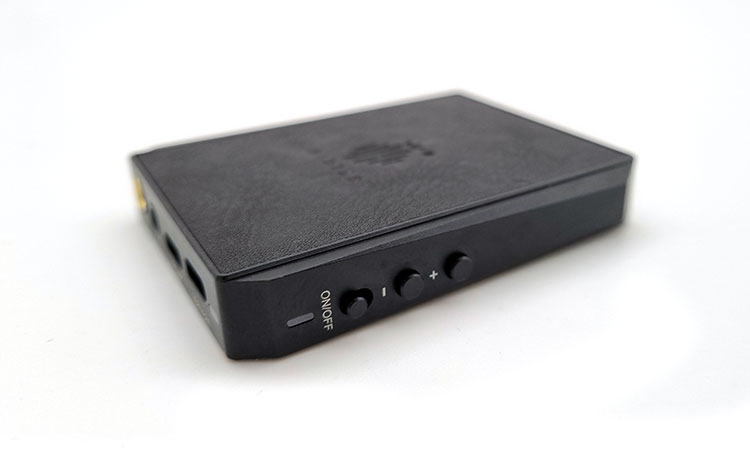
CONTROLS
Given its primary feature set, the DH80s only adopts a few rudimentary controls in its interface, On the left-hand side of its chassis, there is a toggle on-and-off switch for both low, and high-gain. For multiple use scenarios, having a mid-gain toggle would’ve made the DH80s are a more adaptable unit.
On the right-hand side, there are independent volume controls with 30 steps, and a power-on/off toggle switch. To avoid any confusion, Hidizs has opted to include a second LED indicator to reflect the device’s charging status.
Unfortunately, it only lights up green when it is being charged and stays unlit during day-to-day usage, which doesn’t tell us anything about how much power it is currently holding; the information it conveys doesn’t justify its existence.
PACKAGING & ACCESSORIES
Hidizs has stuck to its roots; offering every accessory that is necessary for out-of-the-box usage, leaving no stone unturned. Inside the package, you’ll find a generous package that covers most of the bases including
- DH80s unit
- Type-C USB charger
- USB-A converter
- Type-C to Type-C cable
- Warranty card
- User manual
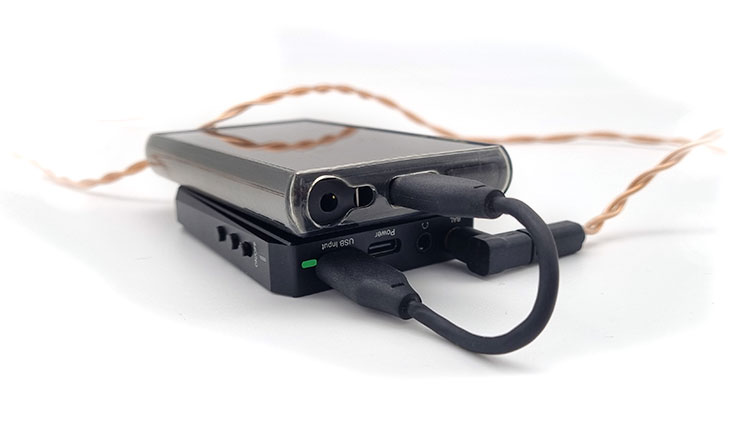
SOUND IMPRESSIONS
SUMMARY
In an ideal setting, a DAC’s job is to recreate any sonic data that was lost from compressing an analog recording into a digital one.
Additionally, the op-amp stage’s primary purpose is to provide adequate power to drive any pair of headphones or IEMs without altering its sound profile. Nevertheless, a multiplicity of factors can result in modifications down the signal path.
To my ears, the DH80s has a slower decay/roll-off that accentuates the low-end, distinctly in the mid-bass section. Treble energy is slightly blunted by the DH80s; any hiss or sibilant peaks are eliminated.
Most importantly, there is a prominent boost in the entire midrange, from its lower mids to the upper mids. Our human biology naturally processes mid-tones far better than any other frequency band. Hence, mid-range clarity is enhanced with the DH80s.
TIMBRE
Because of its non-linear tuning, the low-end response is slightly more voluminous, albeit tastefully enhanced without an overemphasis on punch or rumble. The midrange boost helps to bolster male and female vocals substantially.
However, the treble region’s sharper overtones are dampened (just a touch). All these noteworthy changes naturally create a timbre that oscillates between the realm of neutral and cabin-like warmth (more of the former).
STAGING & DYNAMICS
Arguably the biggest strength of the DH80s is its imaging capabilities. Unlike portable dongles that draw their power from your source’s battery, the DH80’s independent battery allows it to shuttle in more power into either 3.5mm SE or 4.4mm balanced output.
How does it fare in the real world? Lateral width and depth between instruments and vocals are noticeably wider; the perceived space between them is much deeper without sounding artificially distant. Complex tracks fared noticeably paired on IEMs paired with the DH80s.
As alluded to earlier, dynamics from the DH80’s qualitative improvements to the bass regions allow for a wonderful contrast between a clean midrange and the guttural yet restrained low-end punch. Hence, the juxtaposition between those two regions gives it a mild V-shape flavor, albeit very mild.
SYNERGY
POWER
As mentioned earlier, the 3.5mm SE output produces 125mw per channel, and the 4.4mm balanced output provides 210mw per channel. Admittedly, it isn’t the most gargantuan source of power, but what it lacks in aplomb, makes up for qualitative improvements.
Given its pocketable size, one shouldn’t expect the DH80s to power highly inefficient headphones such as the notorious Fostex T50RP. However, it does serve as a wonderful option for new audiophiles testing the waters with affordable, 4.4mm balanced connections; a gateway drug that would still serve a purpose down the line.

PAIRINGS
In this section, the DH80S will be paired with multiple IEMs in ascending order of mechanical impedance and insensitivity, starting with the Moondrop Variations.
The Variations are a reasonably efficient pair of IEMs at 15.2 Ohms and 118dB/Vrms. As expected, the DH80’s 4.4mm balanced output provides copious amounts of power beyond what is necessary.
The Variations’ lateral field is much larger, with precise separation between each sonic element Furthermore, the Variations’ already-rotund bass response is complemented by the DH80s sonic profile.
Jumping to a less efficient IEM, the Kinera Nanna is rated at 60 Ohms, and has a 110dB/mW sensitivity. Thankfully, its nominal impedance and lowered sensitivity do not seem to be a problem on the DH80s. Granted, its internal volume control had to be increased by 4-5 steps, but there was still plenty of room for further volume increases.
Audibly, the Nanna’s shimmery treble occasionally comes across as artificial or synthetic. The DH80S managed to inject dynamism by boosting the low-end and masking some of the not-so-pleasant qualities in the midrange. Consequently, the Nanna’s signature treble is disproportionately veiled, masking some of the qualities that the Nanna is known for.
The final pairing, the Tin Hifi P2+, is a notoriously difficult IEM to drive; even on full-sized desktop amplifiers, one must turn the volume pot to the noon position; driving this IEM is no easy feat.
Unsurprisingly, the DH80S struggles to funnel enough power into its current-hungry planar transducers. The upper-mids to highs sound incredibly veiled, the P2+’s mid-bass punch sounds flabby and unrestrained.
To surmise, this is not a workable pairing. Given the P2+’s unconventional design, the DH80S still deserves some commendation for a valiant effort, albeit an unsuccessful one.

SELECT COMPARISONS
PERIODIC AUDIO NICKEL
TECHNICAL
The Periodic Audio Nickel is an “old-school meets new-school” portable amplifier. Instead of incorporating a modern USB connection, this novel device sticks to the tried-and-tested 3.5mm unbalanced line-in.
The biggest drawback of such a design is the signal coming out of one’s source would not be a fixed line-out. Ingeniously, the Nickel sidesteps those issues by having a huge resistor to avoid double amplification. At 250mW of power output into 32ohms, the Nickel is a worthy contender against the DH80S.
DESIGN
The Nickel is a non-descript, polycarbonate brick with petite dimensions, at 80mm x 30mm x 18mm. Weighing in at just 20grams, this is a highly pocketable solution for grab-and-go users.
At the bottom of the chassis, there are 3 sections: the output, an LED indicator, and the input. Each port is appropriately marked to differentiate them from one another. The micro-USB port is located at the opposite end of the unit.
Operating the device is incredibly simple: if the 3.5mm input is connected, the device powers on as signaled by the LED indicator. Each color corresponds to the amount of charge the Nickel is currently carrying green= full or close to full power, yellow= half-full, red= running out of charge.
In comparison to the DH80S, the Nickel feels less durable under its plastic build, and its featherlight weight. Moreover, users are expected to carry their own dongle DAC to connect it to smartphones with no 3.5mm aux.
More importantly, there are no balanced outputs for audiophiles tempted to test the waters of the 2.5mm/4.4mm balanced world. But, if you’re looking for a solution that takes up far less real estate and a no-frills approach to amplification, the Nickel is one to look out for.
PERFORMANCE
Objectively, the Nickel outputs more power by 45 mW into 32 Ohms as compared to the DH80S’ 4.4mm balanced output. Nevertheless, both units are exemplary amplifiers that achieve similar goals, and in fact, similar sound signatures.
On the Moondrop Variations, both units achieve a strong damping factor by exerting more power and control over the LCP diaphragm, noticeably tightening the low-end. Mid-range and high details sound more prominent, and less congested on either unit.
Comparatively, the nickel slightly edges out the competition by emphasizing the perceived distances between audible cues in more complex passages. The nuances in terms of spatial imaging are more pronounced on the Nickel. However, the DH80S is no slouch, and these differences are too minute for the Nickel to be identified as the superior winner.
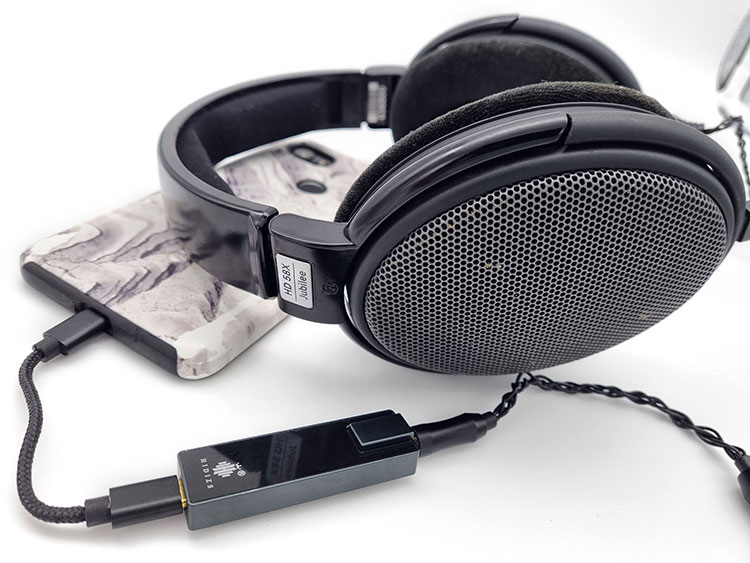
HIDIZS S9 PRO
TECHNICAL
The S9 Pro does not have an independent battery, but it is an interesting comparison, nevertheless. The S9 Pro has been making waves recently for being a highly optimized portable DAC/Amp with exemplary measurements.
Under the hood, the S9 Pro houses an ESS ES9038Q2M, with 200mW into a 32-ohm load in the 2.5mm balanced output, and 100mW into a 32-ohm load in the 3.5mm unbalanced out; impressive measurements for an ultra-portable dongle.
DESIGN
Aesthetically, the Hidizs S9 pro features a simple, oblong dongle with a “t-shaped” cross-section housing the 2.5mm balanced output, and the 3.5mm unbalanced output below. On the opposite end, the S9 Pro has adopted a standard USB-C input that draws but power and data from the playback source.
Moreover, the Hidizs Logo on the S9 Pro doubles down as an LED indicator that represents the bitrate of the song files being sampled: Yellow= DSD64/128, Purple= DSD256/512, Blue= PCM176.4/192(Khz), Red= PCM 352.8/384(Khz), Red= PCM 352.8/384(Khz), White= PCM 705.6/768(Khz), Green= PCM 44.1/48/88.2/96(Khz)
Design-wise, the differences could not be more obvious from a features perspective. The S9 Pro is the convenient option that draws power from the playback device; there is no need to charge a separate device for music playback.
Additionally, the S9 Pro adopts the 2.5mm balanced standard vis-à-vis the newly minted 4.4mm balanced option. If charging an additional device or carrying 2.5mm to 4.4mm convertors is too much of a hassle, the S9 Pro is arguably the better option.
PERFORMANCE
Again, the S9 Pro marginally lacks the power output of the DH80S on both balanced and unbalanced outputs. But how does that translate into real-world sonic performance? The results are somewhat interesting.
The S9 Pro’s distinct house sound is slightly more clinical, emphasizing the grainier details in the treble, alongside instruments and vocals with characteristic upper-mid ranges. Lateral width is above-average, and imaging or separability between instruments/vocals is subtly enhanced.
Conversely, the DH80s adds a slightly neutral-to-warm veil whilst maintaining the technical capabilities of a more neutral sound profile.
However, the biggest differentiator is the DH80S superb spatial width and imaging. Complex passages and violent crescendos are given more elbow room to breathe. In the defense of the S9 Pro, this isn’t the fairest comparison given the DH80S’ independent power source. Nevertheless, a noteworthy effort by the widely revered S9 Pro.
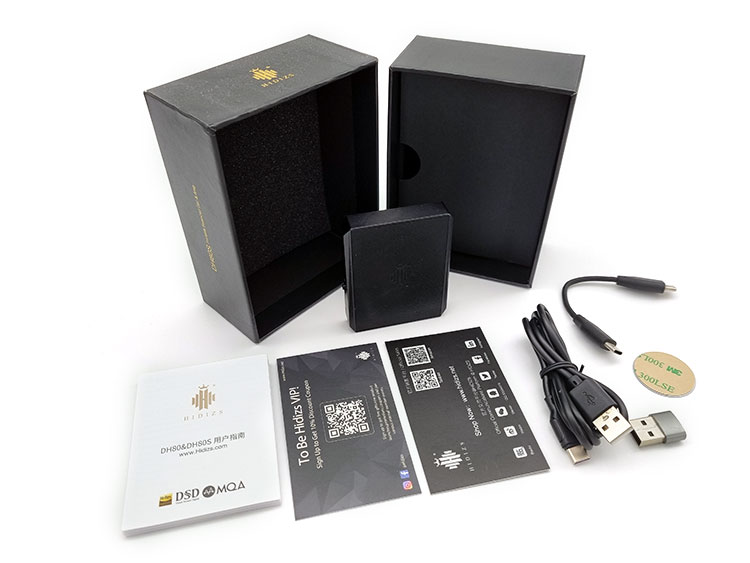
OUR VERDICT
The DH80S is an excellent entry-level balanced DAC/Amplifier that offers tremendous value without breaking the bank. This is the version to get if you enjoyed the sound of the DH80s but don’t have an AP80 Series DAP to experience it.
To surmise, the DH80S is a creative expression of what portable amplifiers can achieve through ingenious design.
HIDIZS DH80S TECHNICAL SPECIFICATIONS
- Hi-Res Audio Certified
- ESS9038Q2M DAC
- PCM: Up to 32bit768kHz
- Native DSD Supports Up to 512
- Single-ended 3.5mm + Balanced 2.5mm
- One-Piece High-Density CNC Aluminum Body
- Sampling Rate Indicator Light
- Powerful Drive Ability. 200mW BAL / 100mW SE
- Compatible with Windows/Android/Mac OS/iOS/iPad OS System


